
One of the biggest advantages of using WhatsApp as a customer communication channel is the possibility of automating repetitive or time-consuming tasks through WhatsApp automation. But for beginners, the idea might sound a bit daunting. In this guide, we’ll explain WhatsApp Business automation benefits, automation options for different business sizes and how to build your own WhatsApp automation bot.
What is WhatsApp Automation?
In simple terms, WhatsApp automation is the automation of conversations on the WhatsApp Business App or WhatsApp Business API. Thanks to it, businesses can save time and resources, improve response times and increase customer satisfaction.
Micro and small businesses can set up basic automation on the WhatsApp Business App from their phone or desktop. This includes welcome and away messages, for example.

This gets trickier for medium and large companies looking to automate repetitive or complex business tasks like chat routing and agent assignment. In the past, this wasn’t possible due to the app’s limitations. But in 2018, WhatsApp API was launched, putting an end to this issue.
Benefits of WhatsApp Automation
Due to the increasing popularity of conversational sales and support, more and more companies are using automation to facilitate customer communication over WhatsApp. WhatsApp automation is on the rise. But why? Here are just a few of the benefits.
Decrease Response Times - WhatsApp auto replies like automated welcome and away messages improve response times and assure customers their message has been received.
Reduce Agent Load - Automation reduces workload by handling certain customer inquiries, such as providing automatic responses to common questions through an interactive FAQ menu.
Increase Sales Conversions - WhatsApp automation ensures that only qualified leads reach agents, saving time and allowing agents to concentrate on genuine sales opportunities. Newer automation options even let AI Agents keep the pipeline clean by qualifying leads, updating records and closing out routine conversations on their own.
Increase Customer Satisfaction - Automation helps route conversations to the right team faster by using pre-chat survey forms to collect customer data and determine conversation purposes. This prompt attention improves overall customer satisfaction.
Turn conversations into customers with respond.io's official WhatsApp API ✨
Manage WhatsApp calls and chats in one place!
4 Use Cases for WhatsApp Automation
WhatsApp automation offers various methods for businesses to streamline their operations. As we’ll cover later, most of these methods require using WhatsApp API.
Firstly, it’s important to understand the role of APIs (Application Programming Interfaces) in WhatsApp automation. APIs enable businesses to integrate their software or systems with the WhatsApp platform, allowing developers to create custom solutions for automating WhatsApp interactions in several ways.
Let’s explore some of the ways businesses can utilize WhatsApp automation.
1. Chatbots
These automated conversational agents can understand user commands and queries. By leveraging machine learning algorithms and Natural Language Processing (NLP), chatbots can instantly provide predefined or AI-generated responses to customers on WhatsApp.
For businesses that need more advanced automation, solutions like respond.io offer AI Agents that go beyond simple replies. They can qualify leads, pull information from your knowledge base, update contact records and route conversations automatically, all without manual intervention.
2. Personalization
By utilizing customer data and sales engagement tools, businesses can send tailored WhatsApp broadcasts, offering a more engaging and customized experience for their customers. Beyond simple name personalizations, companies can segment audiences by behavior, purchase history, Lifecycle stage or past interactions to deliver highly relevant messages.
This level of personalization increases engagement, improves conversion rates and strengthens customer relationships — especially in industries where timing and context matter.
3. Automated Workflows
Businesses can set up workflows on WhatsApp to automate specific tasks and processes. This involves defining rules and triggers that initiate automated actions based on user interactions or other predetermined conditions.
For example, an automated workflow can be created to send order confirmations or appointment reminders to customers automatically.
4. Updates and Notifications
Businesses can schedule WhatsApp messages to send updates and notifications to customers automatically. This includes critical alerts, event reminders, and order status updates, ensuring real-time communication with customers about important information.
Now that you know the benefits and use cases, we’ll dive into how to do WhatsApp automation.
2 Methods to Do WhatsApp Automation
Automating WhatsApp messages depends on the solution you are using, as the process is not the same for WhatsApp Business app and WhatsApp Business API.
When deciding between the WhatsApp Business app and the WhatsApp API for automation, it’s crucial to understand the differences in features and capabilities of each platform. Next, we’ll provide a detailed comparison to help you make an informed decision.
Method 1: Automate WhatsApp through WhatsApp Business App
The simplest method to automate WhatsApp is with the WhatsApp Business app. This app is free to use and is best for small businesses with few users who require only basic automation.
Method 2: Automate WhatsApp through WhatsApp Business API
WhatsApp Business API offers the advanced automation options medium to larger businesses need. To use it, you’ll need to choose a WhatsApp BSP and subscribe to a conversation management platform.
WhatsApp Business App vs WhatsApp Business API - 5 Differences
WhatsApp Business App | WhatsApp API |
|---|---|
Basic Response Automation | Advanced Response Automation |
No Conversation Performance Tracking | Conversation Performance Tracking |
No Integration with Chatbots | Chatbot Integration |
No Interactive Menus | Customizable Interactive Menus |
No Automated Workflows | Supports Automated Workflows |
#1 Response Automation
The WhatsApp Business app provides basic response automation, suitable for simple automated replies. In contrast, WhatsApp API offers advanced response automation, enabling more complex and sophisticated automated interactions.
#2 Conversation Performance Tracking
The WhatsApp Business app does not offer features for tracking conversation performance, making it difficult to measure and analyze interaction effectiveness. WhatsApp API, however, includes conversation performance tracking, allowing businesses to monitor and optimize their customer interactions.
#3 Chatbot Integration
The WhatsApp Business app lacks integration with chatbots, limiting its ability to handle automated customer support. Conversely, WhatsApp API supports chatbot integration, providing a more robust solution for automated customer service.
#4 Interactive Menus
The WhatsApp Business app does not support interactive menus, reducing the potential for engaging customer interactions. On the other hand, WhatsApp API allows for customizable interactive menus, enhancing the user experience with more interactive and guided communication.
#5 Automated Workflows
Although the WhatsApp Business app does not support automated workflows, the WhatsApp API does, enabling businesses to automate specific tasks and processes for improved efficiency.
That said if you run Meta ads that drive WhatsApp conversations, respond.io can send Conversions API (CAPI) events to help Meta optimize delivery. Customers like JU Productions saw a 47.2% drop in cost per qualified lead, while Automax® recorded a 10% lift in conversions after enabling CAPI, a strong boost when paired with WhatsApp automation.
With this understanding, let's explore how to create WhatsApp automation using the WhatsApp Business app.
How to Set Up WhatsApp Automation with WhatsApp Business App
The WhatsApp Business app has some basic automation features that are free to use: Greeting messages and away messages. Let’s see what they look like.
1. Greeting Messages
Greeting messages are one of the most basic features businesses use. Customers appreciate a warm welcome message, and there are several business benefits to using WhatsApp greeting messages.
When enabled, these greeting messages are sent to customers who message you for the first time or after 14 days of inactivity. Greeting messages are customizable, and you can select who receives them from your address book.
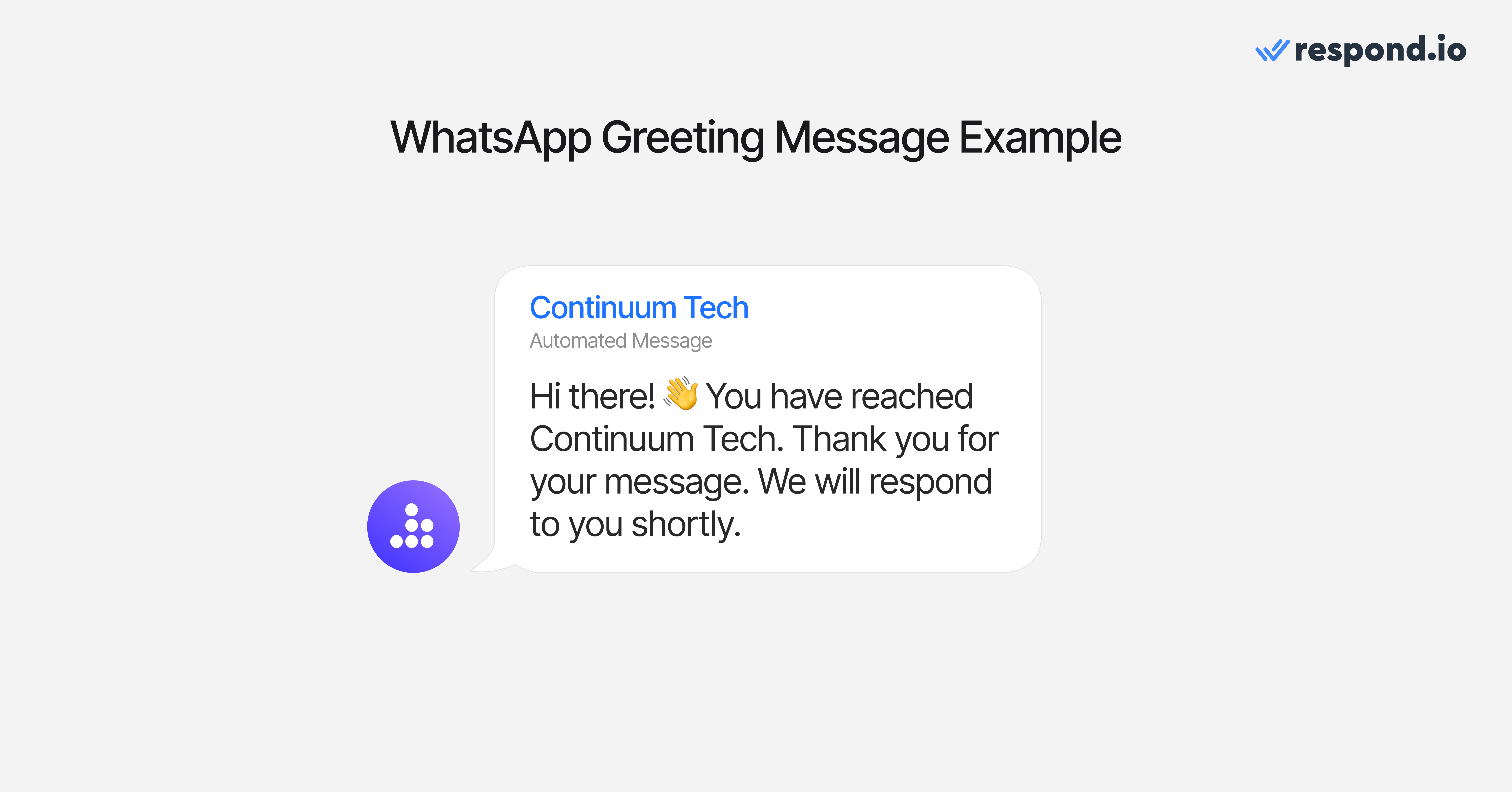
Setting up greeting messages in the WhatsApp Business App is quite easy. You can tailor your WhatsApp greeting message to suit specific purposes and apply recommended best practices to make the most of the message.
2. Away Messages
Unless your business can guarantee immediate responses to all inbound messages, you should have a way to manage wait time expectations.
When enabled, WhatsApp away messages are sent to customers who contact your business outside of office hours or when you’re unavailable. In the WhatsApp Business App, you can define your availability by setting your schedule.
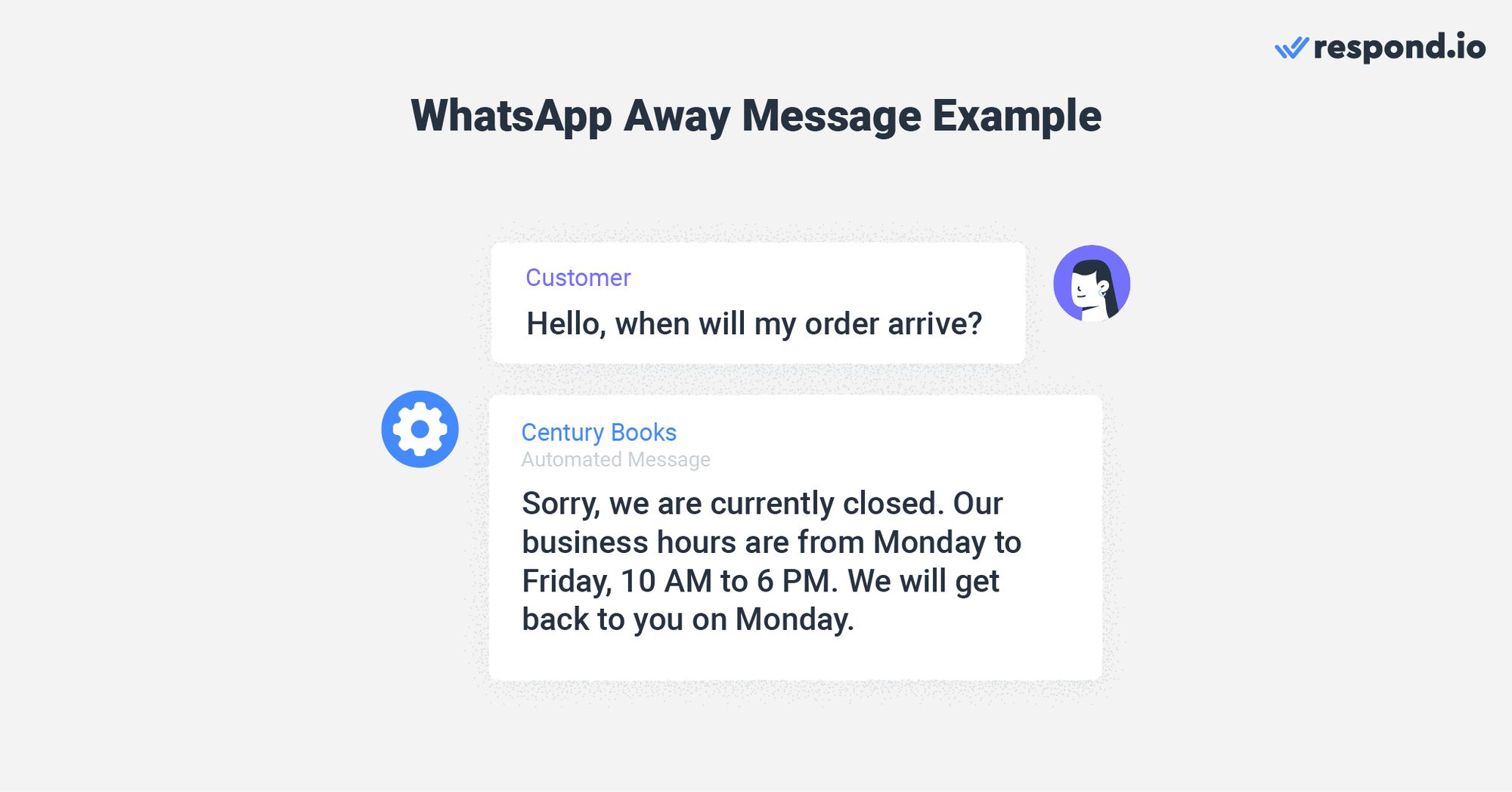
Limitations of WhatsApp Automation with WhatsApp Business App
With only 2 types of auto replies, the WhatsApp Business App is only suitable for small businesses. Let’s recall some of its other limitations.
Basic Response Automation
No Conversation Performance Tracking
No Integration with Chatbots
No Interactive Menus
No Automated Workflows
Medium to large-size businesses will benefit from a more powerful WhatsApp automation tool like WhatsApp Business API.
The Solution? Set up WhatsApp Business Automation with WhatsApp API
Businesses looking to implement advanced WhatsApp API automation with respond.io need to fulfill 2 requirements:
Sign up for a respond.io account
Connect WhatsApp API to respond.io
For respond.io users, the Workflows Module is the place to build a WhatsApp automation bot. This module is available in all the respond.io plans.
First, you’ll first need to acquire some basic knowledge of inbound conversation Workflows. If you are already familiar with this, here are some of the WhatsApp automation you can build from the Workflows Module.
1. Greeting Messages
Greeting messages for WhatsApp can be created from scratch or from a Workflow template such as the Welcome Message or Welcome Message & Ask for Email templates.
By choosing the latter, customer email addresses are saved as Contact Fields for future reference. Email requests will only be sent to customers whose email addresses haven't been recorded previously to avoid asking repetitive questions and annoying them.

To implement greeting messages exclusively for WhatsApp, replace the Last Interacted Channel in the Send a Message Step with your WhatsApp API channel.
In addition, you can customize WhatsApp welcome messages using Dynamic Variables. For example, use the dynamic variable $contact.firstname to greet customers personally and create a friendly first impression.
Greeting customers is important, but so is managing their expectations. Next, we’ll explain how to use Workflows to build a WhatsApp away message.
2. Away Messages
To create a WhatsApp away message with respond.io, build one from scratch or choose a Workflow template.
Choose the Away Message template to automatically send a notification every time a customer starts a conversation. The Workflow needs to be switched on and off manually, so it is suitable for businesses that offer 24/7 support and are seldom unavailable.
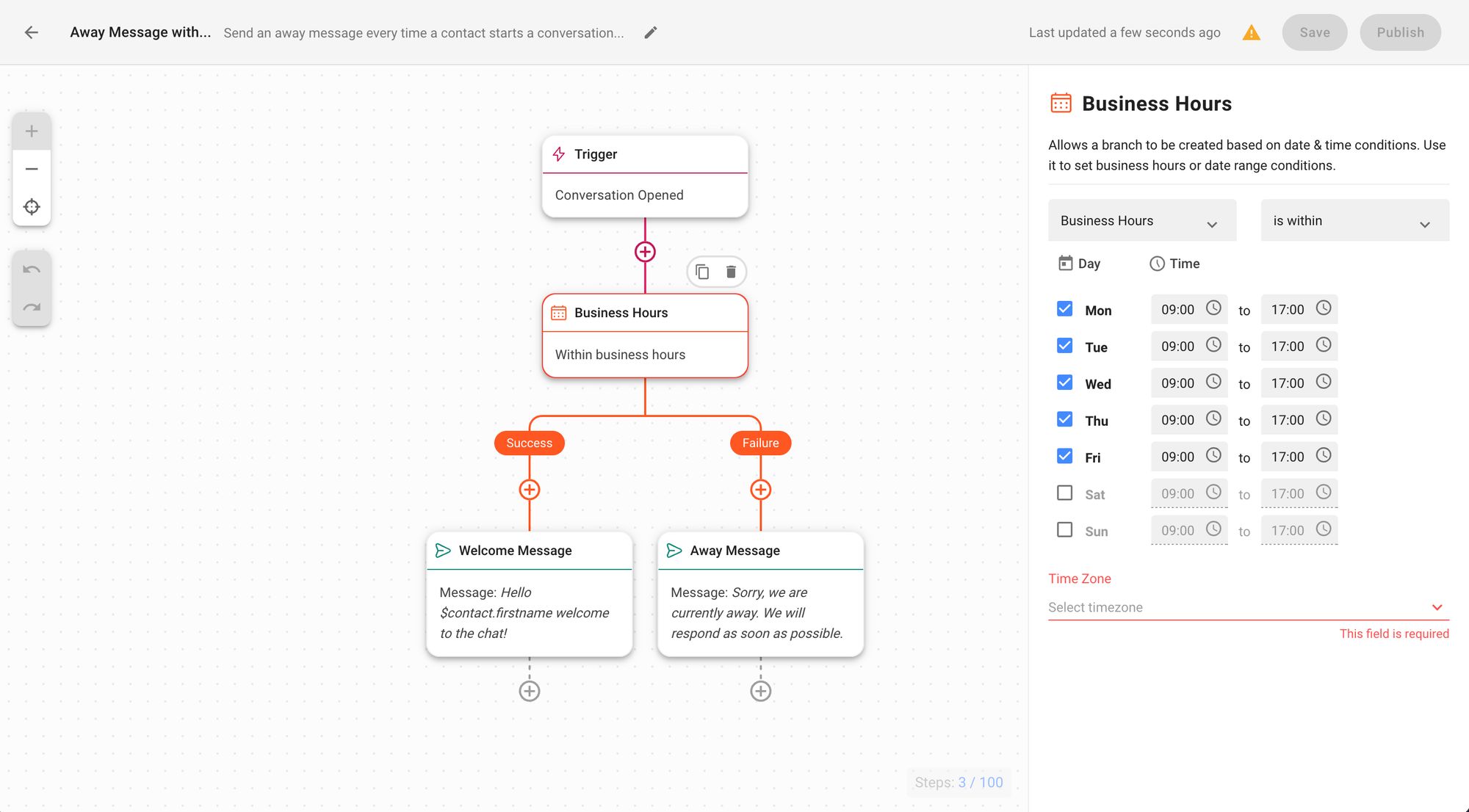
Conversely, use the Away Message with Business Hours template to automatically send a WhatsApp away message outside of operating hours. You just need to enter your business hours in the Date & Time Step to define when away messages will be sent.
So far, we’ve explained how to greet WhatsApp customers that open a conversation with you. Let’s take it one step further by creating a question bot to ask customers questions automatically.
3. Ask a Question
The simplest way to build a question bot with respond.io Workflows is through the Ask a Question Step. This Step has several subcategories to formulate different question types, such as those with multiple choice answers, text or ratings from 1-5 as responses.
There are multiple reasons why a business might ask customers questions when they reach out over WhatsApp. Some businesses like to have a fallback contact method to reach customers after the conversation is closed, so they might ask for an email address.

Although open-ended questions are difficult to categorize and tabulate, businesses may use them to collect qualitative data and insights into customer behavior. For example, a business may ask customers What were the main reasons you chose our service?
To resolve recurring customer queries on the spot, businesses can build automated FAQs using the Multiple Choice question type. This can provide instant answers to common inquiries about pricing, terms and conditions or shipping costs.
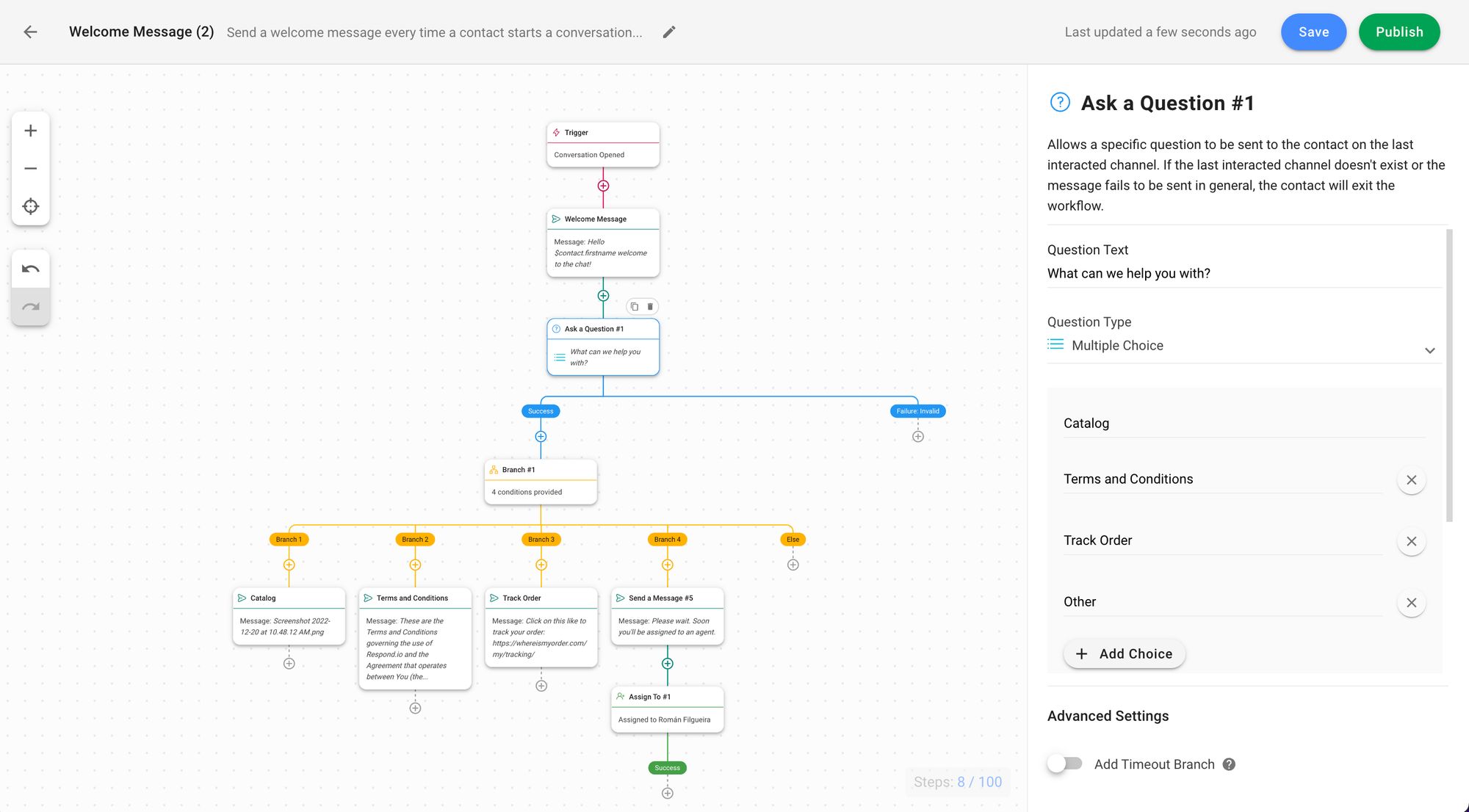
CSAT surveys are used to gauge the level of satisfaction a customer experiences after a specific interaction with a company. You can build a simple Workflow to create CSAT surveys and save the answers to Google Sheets or a data warehouse.
Lastly, an Ask a Question Step can be used to route customers to the right team and auto-assign them to available agents based on the responses provided. Let’s see how it’s done.
4. Assign Chats to Agents
Enterprises with many daily conversations using WhatsApp business with multiple users can’t simply rely on agents to manually pick and resolve them. They need a business solution to route conversations and assign them to agents automatically.
With respond.io, you can build your own routing Workflows from scratch or choose a Workflow template like Multi-team Routing: Shifts, which is ideal for companies with different teams working round the clock that want to assign conversations by shift.
Multi-Team Routing: Multiple Choice by Contact is a Workflow template made for businesses that prefer to route customers based on team functions such as sales inquiries or support requests.
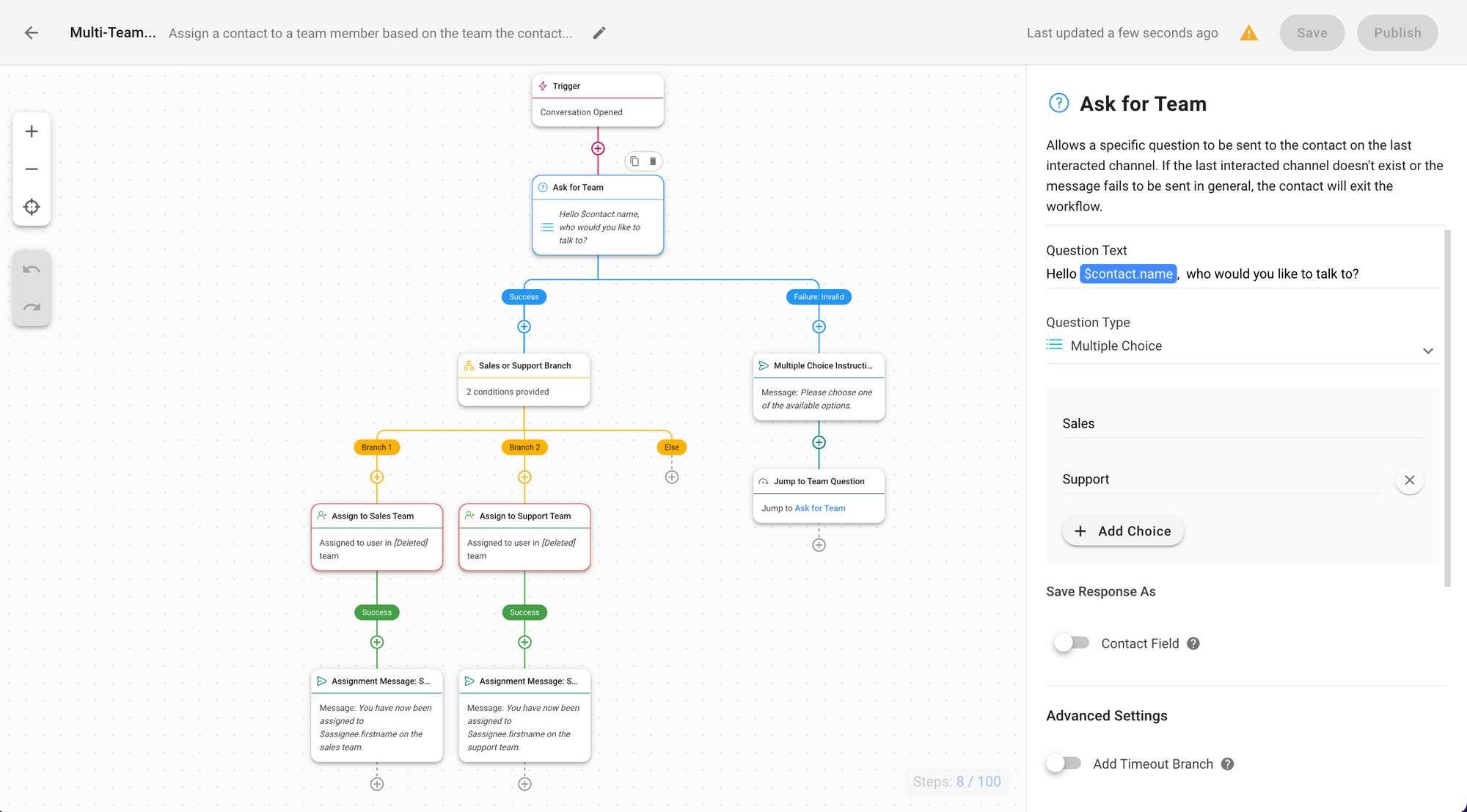
When it comes to automatic agent assignment, Workflow templates will help you get started with 2 logics to choose from: Round-robin to assign conversations equally among agents or by least open contacts for faster service by agents.
5. Build an AI Agent
If you want to take it one step further, you can train a respond.io AI Agent and add it to your Workflow. Beyond replying to messages, AI Agents can also update contact records, adjust lifecycle stages, route conversations and even close conversations automatically with a summary once an interaction is finished.
If you want to give your AI Agent even more autonomy, you'll be happy to know that it can follow up with customers when the conversation is stalled. AI Agents are also able to respond to calls with natural and professional language. There's very little they can't do when it comes to conversational sales and support.
Respond.io’s upgraded AI engine makes these actions even more efficient by processing only the necessary steps for each task—resulting in faster, more accurate responses. And if a human needs to step in, instant takeover ensures the AI stops immediately, preventing message overlap and keeping every handoff smooth.
Businesses use AI Agents for onboarding, lead qualification and 24/7 coverage, while Workflows ensure smooth handoff to human agents whenever the AI is uncertain or a customer requests it.
6. Integrate with 3rd-Party Software
With respond.io’s HTTP Request Step in Workflows, businesses can execute callbacks to third-party applications to transfer data between them and respond.io. These are some common use cases:
Connect a WhatsApp CRM to respond.io
Qualify leads on data enrichment tools
Create deals in sales CRMs or tickets in support CRMs
Save CSAT results in a data warehouse or Google Sheets
But there’s more: Connecting respond.io to Zapier will give you access to more than 5,000 app integrations. Analytics tools, calendar apps, databases… you name it. And just like respond.io's Workflows, Zapier automation does not require code.
6 Examples of WhatsApp Automation Across Different Industries
1. Healthcare
Healthcare businesses can significantly enhance their operations with WhatsApp automation. Virtual waiting rooms keep patients informed and reduce physical overcrowding.
Automating pre-consultation data collection ensures healthcare providers are well-prepared, improving efficiency. Simple cases can be resolved quickly, freeing up time for more complex issues. Complex cases can be escalated seamlessly to specialists, ensuring patients receive the best care.
Additionally, automating patient routing and agent assignment allows for effective tracking and follow-ups, ensuring adherence to treatment plans and appointments.
2. Education
WhatsApp automation can greatly enhance the efficiency of educational institutions. Quickly responding to impatient leads during admissions season ensures no lead is lost due to delays.
Using Respond AI, the leading chatbot for education, institutions can provide instant replies to inquiries and collect data 24/7 before a human agent steps in. Automation can also filter spam, allowing agents to focus on meaningful interactions.
Simplifying processes from event sign-ups to enrollment is seamless with integration into student management systems, CRMs, and ERPs. Additionally, sending event details, reminders, and automated student satisfaction surveys ensures effective communication and continuous improvement.
3. Retail
Here’s how WhatsApp automation can significantly enhance retail operations. For a start, integrating your ERP or sales CRMs allows real-time data retrieval and deal generation during conversations.
Automating the sales pipeline, from lead qualification to abandoned cart recovery, boosts efficiency. For example, creating VIP routes provides dedicated service for high-value clients and enhances customer satisfaction. Also, offering 24/7 support through automated FAQs and human agent access ensures continuous assistance.
Integrating your support CRM facilitates ticket creation during conversations. Additionally, automating processes like support escalation and sending NPS or CSAT surveys streamlines operations and improves the overall customer experience.
4. Automotive
Businesses in the automotive industry can use WhatsApp automation to respond instantly to sales inquiries. When customers are purchasing a car, they’re often making many inquiries. A quick, detailed response can make all the difference in their decision to come in and take a test drive.
If a lead doesn’t need to speak to a salesperson and simply wants to come in to the showroom, you can also automate appointment bookings. Potential customers can book a time slot without needing to wait, and this also frees up sales agents’ time so they can focus on customers who are ready to buy.
Targeted broadcasts for past customers also help keep your business top of mind. For example, one of our customers in the automotive industry retargets those who made a purchase 5 years ago. This is an effective long-term strategy as most people won’t be in the market for a car every year, but a personalized reminder may make your business their first choice.
5. Professional Services
A variety of professional services providers leverage WhatsApp to automate bookings. Whether it’s a cleaning job or a photoshoot, allowing customers to book over WhatsApp streamlines the scheduling process.
Send automated reminders and segment customers based on past services they’ve used to retarget them with the latest promotions and gain repeat business.
It’s also beneficial to send CSAT surveys after every completed service to identify areas for improvement to keep customers coming back.
6. Travel Agency
Travel agencies can use WhatsApp automation to answer FAQ about policies and packages so prospects get the immediate answers they need.
When leads are ready to book a package or have more specific questions that the FAQ can’t answer, set up automation to assign them to an agent. For example, some businesses may send customers to the next available agent while others may assign to an agent specializing in certain destinations.
Once a lead has become a customer, you can schedule WhatsApp messages to keep them updated with reminders and notifications about their travel plans.
Boost Your Productivity through WhatsApp Automation with Respond.io
Ready to set up WhatsApp automation? If you are a micro or small business using the WhatsApp Business App for customer communication, the free in-app automation features may suffice.
However, for most of the use cases we’ve shown, medium to large businesses need to connect WhatsApp API to an omnichannel messaging platform with a powerful workflow builder to systematize time-consuming tasks and handle large numbers of messages efficiently.
To start taking advantage of the benefits of WhatsApp automation, try respond.io for freeor contact us for a customized demo.
Turn conversations into customers with respond.io's official WhatsApp API ✨
Manage WhatsApp calls and chats in one place!
FAQ and Troubleshooting
How to send automated WhatsApp messages?
The WhatsApp Business App includes basic automation features that allow small businesses to send greeting messages, away messages and quick replies without any technical setup. You can enable these by going to Business Tools and selecting the automation you want to activate. From there, customize your message, choose who receives it and set a schedule, such as after business hours.
These tools are helpful for acknowledging messages quickly, setting expectations and reducing simple repetitive tasks. However, they are limited to one-off canned replies and cannot route conversations, qualify leads, collect structured data or integrate with other systems. For businesses that need deeper automation, WhatsApp Business API combined with a platform like respond.io unlocks advanced capabilities such as AI Agents, automated workflows, contact updates and CRM integrations.
Is it possible to send bulk messages through WhatsApp automation?
Bulk messaging is not supported on the WhatsApp Business App due to restrictions designed to prevent spam. However, the WhatsApp Business API does allow businesses to send large-scale broadcasts using WhatsApp’s approved message templates. These broadcasts can contain promotions, reminders, updates or re-engagement messages.
With platforms like respond.io, businesses can segment audiences, personalize variables such as names or purchase details, schedule broadcasts and monitor delivery, open rates and responses. This makes WhatsApp a powerful outbound communication channel for marketing, operations and customer retention. Because broadcasts require opt-in and template approval, they also remain compliant with WhatsApp’s policies, ensuring high deliverability and customer trust.
How can I integrate WhatsApp with my CRM?
To integrate WhatsApp with a CRM, you’ll need a WhatsApp API and a platform that supports CRM connectors or webhooks. With respond.io, businesses can sync contacts, push lead info, create deals or tickets, or trigger CRM workflows based on WhatsApp messages. This centralizes communication and ensures customer data stays updated across systems. Specifically, you can follow the following steps:
Choose the right CRM platform. Ensure that your CRM platform supports WhatsApp integration.
Set up the WhatsApp Business API.
Define communication workflows.
Train your team.
Monitor and analyze performance.
Can WhatsApp automation handle complex customer queries?
Automation can easily resolve routine inquiries like pricing, operating hours, order status or FAQs through chatbots and guided menus. However, complex queries involving emotions, negotiations or nuanced judgment often require a human agent. The best approach is a hybrid model.
Platforms like respond.io use AI Agents to handle initial discovery, answer straightforward questions and collect key details. If the AI detects uncertainty, low confidence or a sensitive topic, it automatically escalates to the appropriate human agent with full conversation context. This ensures customers always get fast responses while still receiving personalized help when needed. Businesses benefit from reduced agent workload while maintaining high service quality.
What tools are available for WhatsApp automation?
In the last few years, chatbot and automation solutions for WhatsApp have multiplied. From the wide array of choices, we recommend using respond.io. Designed and priced for businesses of all sizes, it offers advanced WhatsApp automation capabilities and much more! That said, choosing the right tool depends on your conversation volume, automation needs and whether you require integrations with CRMs, calendars, support systems or data warehouses.
How can I use AI Agents to follow up on customer conversations?
AI Agents can automatically detect when a conversation goes idle and follow up with the customer at the right moment. Unlike basic bots that rely on fixed timers, respond.io’s AI Agent reviews conversation history, message intent and previous actions to determine whether a follow-up is necessary. This prevents unnecessary nudges or repeated reminders. AI Agents can re-engage prospects who paused mid-conversation, request missing information, confirm resolutions or continue qualification steps.
Because follow-ups are contextual, customers experience it as a natural extension of the conversation rather than generic automation. This helps businesses move leads forward, reduce drop-offs and maintain momentum without overwhelming human agents.
Can AI Agents answer business calls?
Yes, AI agents can answer voice calls if you use the right tool. On respond.io, you can configure the AI agent’s voice, add instructions and test the experience before going live. This gives you full control over how calls are handled. Unlike standalone voice bots, respond.io’s AI Voice Agent is fully integrated into a unified inbox, allowing businesses to manage messaging and voice interactions in a seamless thread with every customer, with shared logs and reporting.
Can I get transcripts from customer phone calls?
Yes. With respond.io, VoIP and WhatsApp Business API calls can be automatically transcribed into clear, searchable records. Each call transcript includes speaker names, timestamps and full text, so managers can quickly review conversations without listening to entire recordings. This feature is limited to specific plans.
These transcripts make it easy to audit agent performance, spot coaching opportunities and train new staff with real examples from actual calls. They’re also valuable for compliance and accountability, since all transcripts are securely stored in-platform and can be accessed through the Contact Drawer or Reports Module. This gives managers full visibility across teams and supports consistent, data-driven quality control.
How can AI Agent chats feel less robotic and more human?
AI Agents on respond.io hold natural, human-like conversations by understanding intent, context and tone, not just following scripts. They chat fluidly across WhatsApp, Messenger, Instagram, TikTok and more, drawing context from conversation history and responding according to your rules or criteria.
To make them sound even more human:
Define an AI persona with a tone that fits your brand.
Use typing indicators to mimic real response pauses.
Add short reply delays to avoid instant, bot-like answers.
Feed it quality sources so responses are accurate and contextual.
Allow human handoff for complex or sensitive topics.
The result: fast, natural conversations that feel genuinely human — even when they’re not.
How do I get started with WhatsApp Business API?
To get started, choose a WhatsApp API provider and complete the necessary business verification steps. Respond.io offers a streamlined onboarding process with clear guidance on documentation, approval and setup. Once approved, you can connect your WhatsApp number, configure messaging templates, and begin automating conversations using workflows, AI Agents and integrations. The platform’s setup wizard and help resources walk you through each step, making the entire process beginner-friendly even for non-technical teams.
Have a look at our one-stop guide to learn more: How to Get WhatsApp API.
Can I track lead stages when automating WhatsApp?
Yes. When using the WhatsApp Business API with a platform like respond.io, you can assign every contact a Lifecycle stage such as New Lead, Hot Lead, Payment or Customer.
These stages update automatically through workflows or AI Agents as conversations progress, so teams always know where each lead stands. Automation can qualify leads, move them to the right stage, route them to sales or follow up if they stall. This creates a clear, trackable funnel inside WhatsApp without relying on spreadsheets or external CRMs.
For businesses running high-volume WhatsApp operations, Lifecycle provides a simple way to prioritize high-intent contacts, monitor conversion health and understand exactly how leads move from first message to paying customer.
How does Meta’s Conversions API (CAPI) work with WhatsApp automation?
Meta’s Conversions API (CAPI) allows businesses to send server-side conversion events directly to Meta, improving the accuracy of ad attribution and optimization. On respond.io, you can trigger CAPI events when a WhatsApp lead is created, qualified, updated or converted.
This gives Meta clearer signals about which ads generate high-quality leads, allowing the algorithm to refine targeting and reduce acquisition costs over time. CAPI is especially valuable for businesses that automate WhatsApp qualification or track funnel stages, because it ties real outcomes—not just clicks—to your campaigns. Customers using CAPI through respond.io have seen significant performance gains, including lower cost per qualified lead and higher conversion rates.
Further Reading
Did you find this reading interesting? If so, we suggest you have a look at the following articles.




























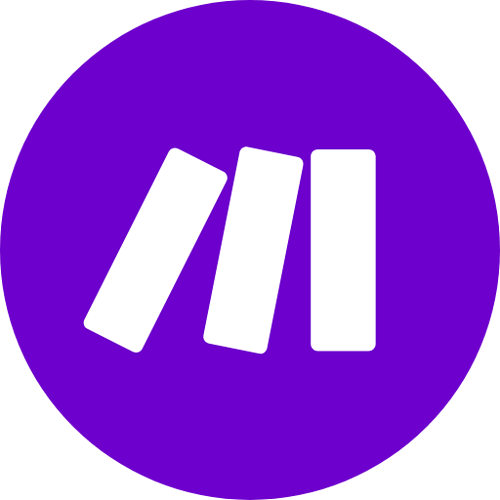









 Electronics
Electronics Fashion & Apparel
Fashion & Apparel Furniture
Furniture Jewelry and Watches
Jewelry and Watches
 Afterschool Activities
Afterschool Activities Sport & Fitness
Sport & Fitness
 Beauty Center
Beauty Center Dental Clinic
Dental Clinic Medical Clinic
Medical Clinic
 Home Cleaning & Maid Services
Home Cleaning & Maid Services Photography & Videography
Photography & Videography
 Car Dealership
Car Dealership
 Travel Agency & Tour Operator
Travel Agency & Tour Operator




